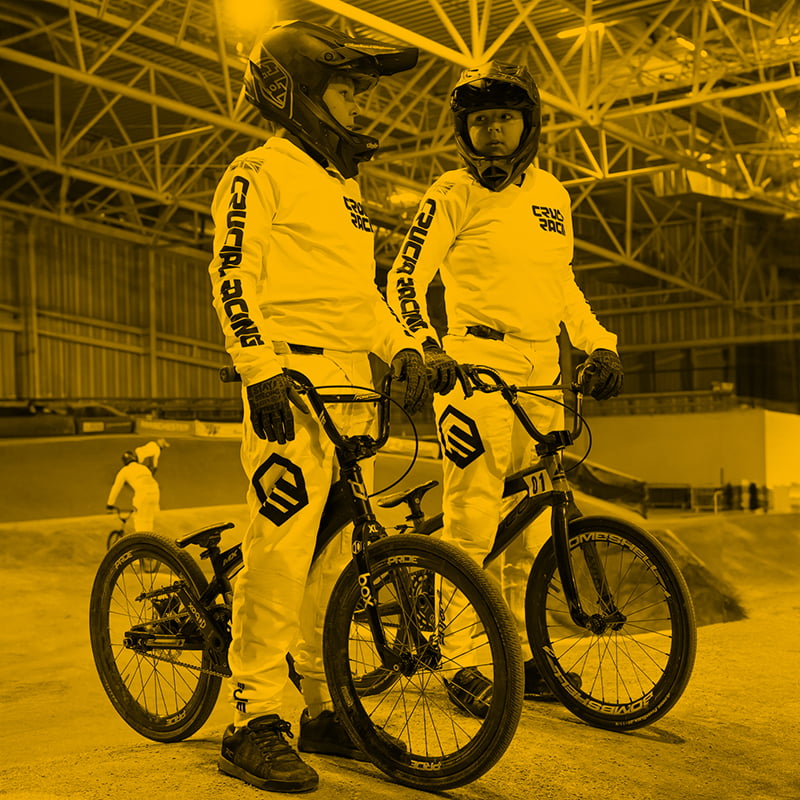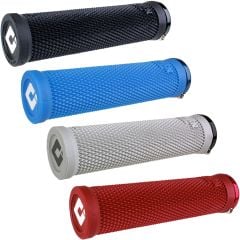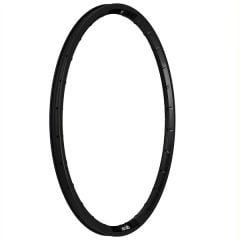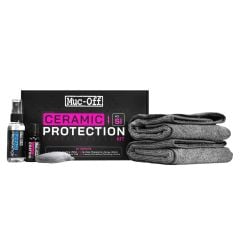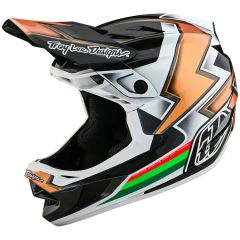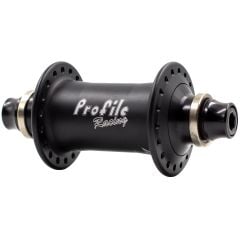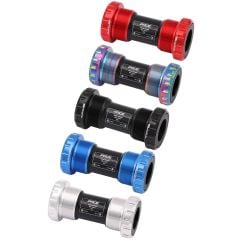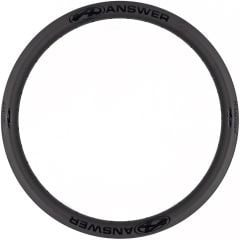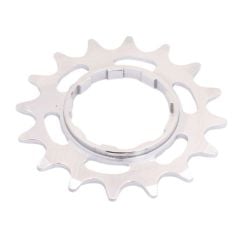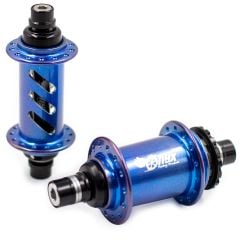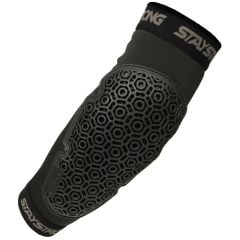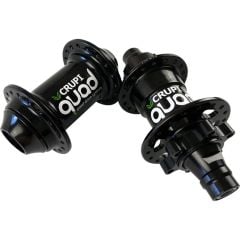Pure V6 BMX Race Frame
The Pure Bicycle Company are continuously working to push the boundaries of performance and design.... Read More
The Pure Bicycle Company are continuously working to push the boundaries of performance and design. The V6 Aluminium BMX frames are a combination of modern technology combined with a passion for BMX racing. They are made from the highest quality 6061 series hydro formed aluminium with rear chainstays designed to reduce the power loss during pedalling to increase performance. Larger tubing adds stiffness to the rear end of the frame resulting in better gate starts and better acceleration. All tubing used to construct the frame has been chosen to maximise power transfer so that everything you can put through the pedals goes onto the track without losing any through the frame. Hydro Formed tubing reduces flex in the frame when you are pushing and pulling on the bars making for a more responsive ride and quicker response in the turns. The short seat tube allows you to run the seat as low as possible without any tyre buzz during manualing and the included disc adaptors mean the frame is disc ready right out the box. Extremely balanced geometries keep the frame stable when jumping making for more confident riding, allowing the racer to really push their limits.
- CNC Machined head tube, bottom bracket shell and 3D dropouts
Hydro Formed 6000 Series Tubing - Tubing Designed for Maximum Power Transfer
- Stainless Steel drop out inserts for increased drop out life
- Extremely balanced geometries
- 10mm Dropouts
- Euro Bottom Bracket
- Responsive front end
- Short Seat Tube
- 3M Vinyl Graphics
- Removable V-Brake mounts
- Disc Brake Adaptor Included
- Chain Tensioner/Axle Adjuster Included
We have raw stock available for custom colours meaning faster turnaround than any other brand. Email [email protected] or give us a call for more information and pricing.
Please note, when running disc, a Shimano XTR Mount Adaptor for your disc size must be purchased separately
Junior
- Top Tube: 18.71”/475.2mm
- Rear End: 12.5”/317.5mm
- BB Height: 11.04”/280.39mm
- Rider Area: 19.25”
- Head Angle: 72°
- Set Tube angle 71°
- Post Size/Clamp Size: 22.2mm/25.4mm
- Headset: 1 1/8 Integrated
- Weight: 1.26kg
Expert
- Top Tube: 19.33”/491mm
- Rear End: 12.5”/317.5mm
- BB Height: 11.04”/280.39mm
- Rider Area: 19.7”
- Head Angle: 72°
- Set Tube angle 71°
- Post Size/Clamp Size: 22.2mm/25.4mm
- Headset: 1 1/8 Integrated
- Weight: 1.28kg
Expert XL
- Top Tube: 20.24”/514mm
- Rear End: 12.99”/330mm
- BB Height: 11.04”/280.39mm
- Rider Area: 20.6”
- Head Angle: 72°
- Set Tube angle 71°
- Post Size/Clamp Size: 27.2mm/31.8mm
- Headset: 1/8 Integrated
- Weight: 1.42kg
Pro JR
- Top Tube: 20.5”/521mm
- Rear End: 13.2”/335mm
- BB Height: 11.04”/280.39mm
- Rider Area: 20.7”
- Head Angle 73°
- Set Tube angle 71°
- Post Size/Clamp Size: 27.2mm/31.8mm
- Headset: 1 1/8 Integrated
- Weight: 1.62kg
Pro
- Top Tube: 20.91”/531mm
- Rear End: 13.43”/341.2mm
- BB Height: 11.63”/295.4mm
- Rider Area: 21.4”
- Head Angle 74°
- Set Tube angle 71°
- Post Size/Clamp Size: 27.2mm/31.8mm
- Headset: 1.5” Tapered
- Weight: 1.72kg
Pro XL
- Top Tube: 21.54”/547mm
- Rear End: 13.78”/350mm
- BB Height:11.63”/280.39mm
- Rider Area: 21.75”
- Head Angle 74°
- Set Tube angle 71°
- Post Size/Clamp Size: 27.2mm/31.8mm
- Headset: 1.5” Tapered
- Weight: 1.76kg
Pro XXL
- Top Tube: 22.17”/563mm
- Rear End: 13.78”/350mm
- BB Height: 11.63”/280.39mm
- Rider Area: 22.5 inches
- Head Angle 74°
- Set Tube angle 71°
- Post Size/Clamp Size: 27.2mm/31.8mm
- Headset: 1.5” Tapered
- Weight: 1.78kg
Pro XXXL
- Top Tube: 23.05”/585mm
- Rear End: 14.37”/365mm
- BB Height: 11.63”/280.39mm
- Rider Area: 23.0”
- Head Angle 74°
- Set Tube angle 71°
- Post Size/Clamp Size: 27.2mm/31.8mm
- Headset: 1.5” Tapered
- Weight: 1.82kg
Pro XL Cruiser
- Top Tube: 22.0”/559mm
- Rear End: 14.76”/375mm
- BB Height: 11.65”/295mm
- Rider Area: 22.75”
- Head Angle 74°
- Set Tube angle 71°
- Post Size/Clamp Size: 27.2mm/31.8mm
- Headset: 1.5” Tapered
- Weight: 1.84kg
Pro XXL Cruiser
- Top Tube: 23.0”/584mm
- Rear End: 14.76”/375mm
- BB Height: 11.65”/295mm
- Rider Area: 23.6”
- Head Angle 74°
- Set Tube angle 71°
- Post Size/Clamp Size: 27.2mm/31.8mm
- Headset: 1.5” Tapered
- Weight: 1.88kg
All frame weights stated based on raw frames
- Colour: Satin Black, Satin White
- Lead Time: 0
New Rider?
Choosing the correct bike for your discipline is extremely important, and sometimes for those new to the sport it can be difficult to know or decide, so we’ve broken down the main differences to help you make a decision.
Freestyle bikes are designed for the skatepark, the streets or the trails. They are constructed from strong, hard wearing materials and usually feature Steel or Chromoly frames. This means that the bike can stand up to a certain amount of impacts and hard landings, but remember no bike is indestructible. For riders looking to learn tricks and stunts, then a freestyle bike is the correct choice.
Race bikes are designed specifically with the track in mind, they are nimble lightweight machines for putting down quick lap times. Typically, they are constructed from lightweight materials like aluminium and carbon fibre to keep the weight down and the rider at the front of the pack. These bikes are strong enough for smooth landings on race and pump tracks but will not take the abuse that a freestyle bike would in concrete skateparks. If you’re looking to set fast lap times or begin your competitive career on the track, a race bike is the right choice.
Choosing the correct size BMX bike is very important, bikes that are too large will be cumbersome and hard to manoeuvre and bikes that are too small can feel cramped and hard to keep under control.
Youth freestyle bikes are sized depending on the diameter of the wheel staring at 12” all the way through to 18”, at a 20” wheel the bike is considered an adult size. Adult freestyle bikes are sized on top tube length, a 18.5” top tube is extra small for younger teenagers who have just moved up to an adult bike, a 20” top tube is small, 20.5” a medium and anything over a 21” is considered large.
Race bikes feature 20-inch wheels on all models, but the components and frame are sized dependent on age and height. Youth race bikes start from a Micro size for very young riders and offer a range of sizes through to expert XL. Pro size and upwards are considered adult bikes and are usually offered up to a Pro XXXL or larger for very tall riders.
We recommend consulting our height charts from the link below to help you choose your perfect sized bike:
Choosing the right level bike for your riding ability is important. Components that are not suitable for your level of riding can wear or fail much sooner than expected. Although BMX bikes can look very similar, under the surface components and materials used can vary greatly.
All our bikes are cherry picked from the very best BMX specialist brands, and all our bikes are designed specifically for use at the skatepark or on the track.
FREESTYLE BIKES
For first time riders new to the sport our entry level bikes, priced from £200-£400, are perfect, most of these are made from high tensile steel which means they are still relatively strong, but can be slightly heavier than higher end models. You might find you’ll want to upgrade to something lighter sooner than you’d think. If you are planning on using the bike in rain or bad weather, we do strongly advise choosing a model with fully sealed bearings all round.
If you are already confident on a bike and have some experience in skateparks or performing tricks and jumps then we would recommend choosing a mid-range bike, priced from £400 to £700, with a full Chromoly frame, fork, and bars. This will be lighter and stronger than an entry level model.
For an experienced person that is already capable of performing most tricks and has previously owned BMX bikes then a high-end complete bike, or full custom would be suggested to meet the demands of this rider, these bikes are priced from £700 plus.
RACE BIKES
Our range of entry level race bikes are perfect for first time racers, usually priced between £200 and £400 most of these are constructed of heavier steel rather than aluminium. These are great to get a feel for the sport but would not be able to keep up in a competitive environment.
Our mid-range race bikes are the perfect for riders who are beginning their path to competitive racing. Priced between £400 and £800 these are not quite the high-end steeds you see at national level races, but they all feature lightweight aluminium frames and are designed specifically with the racetrack in mind.
For experienced riders who are already racing confidently at a competitive level we offer a small range of high-end complete bikes. These are usually priced between £800 and £1500 and feature many aftermarket components like carbon forks, disc brakes and folding tyres. However, at this level we highly recommend building a full custom bike, usually costing between £1500 and £3000 all components can be chosen specifically with the rider in mind. For help on building a custom bike give us a call or drop us an email!
One of our most frequently asked questions in freestyle is, which rear hub do I want, a freecoaster or a cassette? Most experienced riders know their preference, but if you’re new to the sport it can be difficult to know which choice to make.
The main difference between the two is the way the bike performs when going backwards. A traditional cassette hub requires the rider to pedal in time with the rotation of the wheel while travelling backwards, while a freecoaster allows the rider to travel backwards while keeping the pedals level in the same position as riding forwards.
Although this may seem like a brilliant feature, it does come at a price! Freecoaster hubs feature a “Slack” before engagement while pedalling forward. This means that you can turn the crank a set amount (Usually an adjustable amount) before the drivetrain engages. This is referred to as the “Slack”, when riding backwards you must keep your feet positioned within the slack, if your pedals rotate too much the drivetrain will engage and your pedals will start to rotate. The smaller the slack, the harder it is to keep your pedal positioned within it while riding backwards. This means that certain tricks are harder to perform, especially those that rely on pedal pressure, for example Tire Taps.
